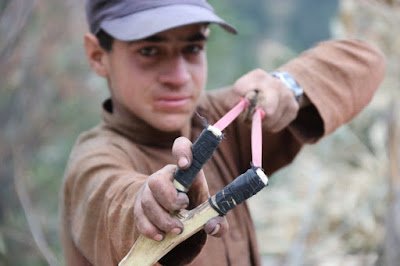We need to start our children young when it comes to repping so that they will always depend on what you taught them should SHTF come. One of the best ways to teach them survival and prepping skills is through play. Play helps kids build a sense of their own identities and abilities. And it is through play that children learn essential life skills such as problem-solving, teamwork, and self-confidence.
These enjoyable DIY activities will not only be great projects for bonding time with your kids but are also helpful ways to prepare them for the prepper life.
Slingshot
Slingshot is a great weapon and toy for kids while they’re still to young to hold bows and rifles. A survival slingshot can still help them secure a game and protect themselves. Versatility is important in survival, and the sling’s benefit is its tiny size. Here’s how you can create a survival slingshot with your kids.
- Find a Y-shaped tree branch made of oak, ash, dogwood, hickory, or maple.
- Dry the wood. Start a campfire and set the branch near the flames. This will take hours to finish, but it’s worth it! You may also opt to simply microwave it.
- Carve notches in your fork. Create one notch on each of your fork’s “prongs” at roughly the same height.
- Cut your tubing. Measure how long you want it to be. The shorter the tubing, the greater the force of the shots. But don’t make it too short since it might be hard to pull the bands back.
- Attach tubing to the fork. Wrap one end of the tubing around your notch so that it doubles back on itself like in the photo. Tie the end of the tube to the rest of the tube with some dental floss. Wrap the dental floss as tight as you can, tie it off, and cut off any long ends. Repeat on the other side.
- Attach the pouch to the tubing and enjoy!
Making a Cordage Out of Grass
Survival bracelets made of paracord are so popular nowadays, but you and your children can just create one of your own! Grass isn’t really the strongest option but it’s better than not having any at all. You’ll need long grass for this. Do a standard three-strand braid on it, although one strand should be composed of multiple strands of grass. it’s better than not having any at all. You’ll need long grass for this.
- Tie off the end of the grass on a tree branch to anchor it.
- Start braiding as mentioned. Make sure that none of the three strands reaches a point where it runs out of length or where all of the grass is being replaced at the same time. You also do not want to start a new piece of grass just where another ends; rather, you want to start it a couple of crossings before, to maintain the cord’s strength.
- Tie off the end of the cord by wrapping around it with grass and tying. Do the same back at the start end, and then cut it off of the branch it was anchored to.
Conserving Energy
This is not really a DIY project, but a great survival activity that will teach your children a lot. Here are some great ways you can teach the kids to live without lights.
- Have a “lights out drill” by turning off all the light and ask your kids to locate flashlight and candles. Guide them but don’t let them ask for help.
- Purchase a hand-powered “crank” radio and show your kids how to operate it.
- Invite the kids to search for energy wasters in your home like unused cords plugged in, drafty doors and windows, dripping faucets, and appliances and electronics left on when not needed
Container Garden
There are many food items you can plant with your kid even without taking up space in your garden. One of the easiest container garden project is growing celery from the bottom of a bunch. All you need to do is buy a bunch of celery and follow these steps:
- Place the celery bottom in water. In a day or two, you should see growth.
- Once it roots, you can plant the celery bottom in a container and grow celery stalks or leaves.
Other food items you can grow with your kids include garlic, sweet potatoes, and more! Good containers you can try include mason jars, cans, and even eggshells!
Learn More:
Reference Link: https://primitivesurvivors.com/diy-survival-projects-for-kids/

No comments:
Post a Comment